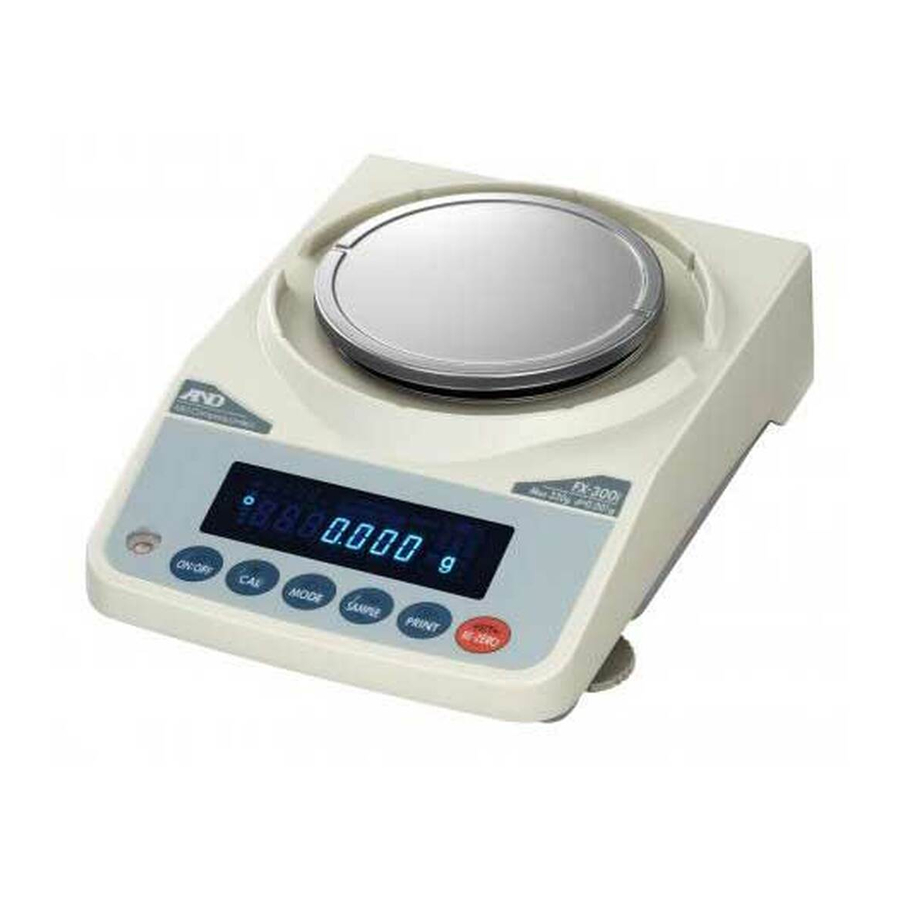Summarization of Contents
1. INTRODUCTION
1-1 About This Manual
Describes the manual's structure, covering basic operation, environment adaptation, functions, interface, and maintenance.
1-2 Features
Highlights key capabilities of the FZ-i WP and FX-i WP series balances, including dust-tight design and fast response.
1-3 Compliance
Details compliance with FCC Rules and EMC Directives, including CE marking information.
2. UNPACKING THE BALANCE
2-1 Unpacking
Instructions for carefully unpacking the precision instrument and verifying contents.
2-2 Installing the Balance
Step-by-step guide for placing, assembling components, leveling, and connecting the balance.
3. PRECAUTIONS
3-1 Before Use
Essential guidelines for operating environment, installation, and initial setup for accurate weighing.
3-2 During Use
Precautions during weighing, covering atmospheric pressure, static electricity, and sample handling.
3-3 After Use
Recommendations for cleaning, avoiding immersion, and safe handling after operation.
3-4 Power Supply
Information on power connection, standby mode, and the importance of warm-up time.
3-5 Display Symbols and Key Operation
Explanation of balance display indicators and the function of each key.
4. WEIGHING UNITS
4-1 Units
Lists available weighing units, their displays, function table settings, and conversion factors.
4-2 Storing Units
Procedure for selecting and arranging the sequence of weighing units in the function table.
5. WEIGHING
5-1 Basic Operation (Gram Mode)
Step-by-step guide for performing standard weighing operations in gram mode.
5-2 Counting Mode (PCS)
Instructions for using the counting mode to determine the number of objects by unit mass.
5-3 Percent Mode (%)
Guide for using percent mode to display weight relative to a 100% reference mass.
5-4 Statistical Calculation Mode
Enables statistical calculation of weight data, including sum, average, and deviation.
5-4-1 Getting Started
Steps to switch to and configure the statistical calculation mode via the function table.
5-4-2 Using The Statistical Calculation Mode
Detailed steps for entering data and obtaining statistical results.
5-5 Statistical Calculation Mode (Example of Use)
Illustrates using the statistical mode for a practical application like mixing formulas.
5-5-1 Getting Started
Configuration steps for enabling statistical mode and 'zero after output' for the example.
5-5-2 Using The Statistical Calculation Mode
Demonstrates the process of mixing, recording data, and outputting results in the example.
7. CALIBRATION
7-1 Calibration Mode
Overview of calibration methods: internal mass, external weight, and test.
7-2 Calibration Using the Internal mass (One-Touch Calibration, only for FZ-iWP series)
Procedure for performing one-touch calibration using the balance's internal mass.
7-3 Calibration Using an External Weight
Detailed steps for calibrating the balance with an external weight.
7-4 Calibration Test Using an External Weight
Procedure for testing weighing accuracy using an external weight.
8. FUNCTION SWITCH AND INITIALIZATION
8-1 Permit or Inhibit
Setting switches to permit or inhibit changes to balance parameters.
8-2 Initializing the Balance
Procedure to return various balance parameters to their factory default settings.
9. FUNCTION TABLE
9-1 Structure and Sequence of the Function Table
Explains the two-layer structure (Class and Item) of the function table.
9-2 Display and Keys
Details the meaning of display symbols and the function of keys used in the function table.
9-3 Details of the Function Table
Comprehensive list and description of all items and parameters within the function table.
9-4 Description of the Class “Environment, Display”
Explains parameters related to environmental conditions and display settings.
9-5 Description of the Item “Data Output Mode”
Details settings for various data output modes like Key mode and Stream mode.
9-6 Description of the Item “Data Format”
Defines different data output formats such as A&D standard and DP format.
9-7 Data Format Examples
Provides visual examples of how data appears in different output formats.
9-8 Description of the Item "Application Function”
Explains application functions like Capacity indicator and Statistical calculation mode.
9-9 Comparator Function
Instructions for setting up the comparator function with upper/lower limits.
9-10 Clock and Calendar Function
Guide for setting and confirming the balance's internal clock and calendar.
10. ID NUMBER AND GLP REPORT
10-1 Setting the ID Number
Procedure for setting a unique ID number for Good Laboratory Practice (GLP).
10-2 GLP Report
Details on outputting calibration and test reports for GLP compliance.
Title block and end block
Describes the insertion of title and end blocks in GLP data records.
14. CONNECTION TO PERIPHERAL EQUIPMENT
14-1 Connection to the AD-8121B Printer
Setup instructions for connecting and configuring the AD-8121B printer.
14-2 Connection to a Computer
Guidance on connecting the balance to a personal computer via RS-232C or USB.
14-3 Using Windows Communication Tools (WinCT)
Using WinCT software for PC communication, data analysis, and balance control.
15. COMMANDS
15-1 Command List
Lists commands for querying weight data and controlling the balance.
15-2 Acknowledge Code and Error Codes
Explanation of acknowledge codes and error codes received from the balance.
15-3 Settings Related to the RS-232C
Configuration of 'Data output' and 'Serial interface' functions for RS-232C communication.
17. TROUBLESHOOTING
17-1 Checking the Balance Performance and Environment
Guide to diagnosing and resolving issues related to balance performance and operating conditions.
17-2 Error Codes
Explanation of various error codes displayed by the balance and their meanings.
17-3 Asking For Repair
Steps to follow when requesting service or repair for the balance.















Need help?
Do you have a question about the FZ-3000iWP and is the answer not in the manual?
Questions and answers